Wigandia: a garden of the sun

I first learned of William Martin and his iconoclastic garden, Wigandia, several years ago when he spoke at the Vista lectures in London (I listened to all the Vista podcasts). Shortly after, he discovered my garden through my blog, and an intermittent dialogue and friendship began. Wigandia has been widely publicized in books and magazines, and has been chosen as the best Australian garden twice. But it is not an easy place to get to, situated as it is on the side of an ancient volcanic cone, Mount Noorat, about three hours drive east of Melbourne. When Phil and I planned a trip to Australia and New Zealand in February of this year, a visit to meet William Martin and see Wigandia was at the top of my list.
Few gardens I've ever visited so completely reflect the spirit of their place--and this place is extraordinary: a sun-beaten, volcanic hillside, with views out to a bare, arid landscape of round-top hills, a few trees amid brown grasslands, pastoral views of distant grazing cows, really only dots on the landscape, and a huge sky over it all. Brilliant sunlight dominates everything.To be sure, it is a “garden of the sun.” First visiting Wigandia, standing on that red volcanic scoria on a day of intense heat, one of many that had left the garden just about as stressed as a garden can get, the uppermost thought in my mind was of the sun. As I gazed across a garden of plants glazed by brilliant sunlight, almost dripping with light ...
First visiting Wigandia, standing on that red volcanic scoria on a day of intense heat, one of many that had left the garden just about as stressed as a garden can get, the uppermost thought in my mind was of the sun. As I gazed across a garden of plants glazed by brilliant sunlight, almost dripping with light ...
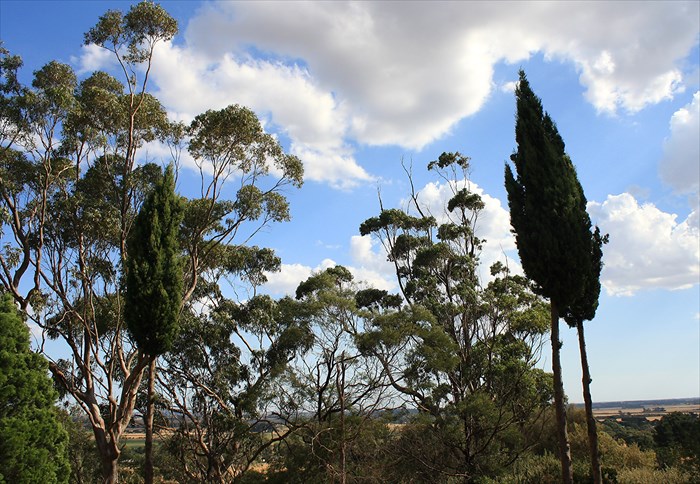 ... Donne's “like gold to airy thinness beat” came to mind, light appearing to be a substance like gold that can be worked so thin it becomes virtually transparent ...
... Donne's “like gold to airy thinness beat” came to mind, light appearing to be a substance like gold that can be worked so thin it becomes virtually transparent ...
 ... a thin veil of brightness limning the plants, giving them presence, clarity, potential to be more than they are, even those shriveling from lack of water, turning brown and gold, shaggy and parched ...
... a thin veil of brightness limning the plants, giving them presence, clarity, potential to be more than they are, even those shriveling from lack of water, turning brown and gold, shaggy and parched ... ... as are these banks of New Zealand Rock Lily (Anthropodium cirratum) at one side of William Martin's house. What might just be masses of dry, very stressed plants in another garden, when viewed in the afternoon light of Mount Noorat, and set amid color combinations designed by William Martin, are transformed into glorious mounds, terraces spilling out like fountains.
... as are these banks of New Zealand Rock Lily (Anthropodium cirratum) at one side of William Martin's house. What might just be masses of dry, very stressed plants in another garden, when viewed in the afternoon light of Mount Noorat, and set amid color combinations designed by William Martin, are transformed into glorious mounds, terraces spilling out like fountains.
 William, mockingly, jokingly, accused me of observing his garden entirely through my camera viewfinder. He was right to say that, but my camera's eye view gave me an entry point, a way to find my way into the garden, to sort out relationships, likenesses, differences amid the visual complexity. So after a while looking, framing, photographing, I raised my head from the internal workings of that device and, almost like an epiphany, the garden opened up. I became aware of space, air, light, the surrounding hills. The experience felt like revelation.
William, mockingly, jokingly, accused me of observing his garden entirely through my camera viewfinder. He was right to say that, but my camera's eye view gave me an entry point, a way to find my way into the garden, to sort out relationships, likenesses, differences amid the visual complexity. So after a while looking, framing, photographing, I raised my head from the internal workings of that device and, almost like an epiphany, the garden opened up. I became aware of space, air, light, the surrounding hills. The experience felt like revelation. Wigandia is an extraordinarily beautiful garden, but I think many people may not be able to see that, especially if visiting when we did, during severe drought. That's a shame.
Wigandia is an extraordinarily beautiful garden, but I think many people may not be able to see that, especially if visiting when we did, during severe drought. That's a shame. How extraordinary that a garden, parts of which are dried to a crisp, parts wilted, parts dead, can be at a visual peak when most gardens are at their worst. It's a creative mess ...
How extraordinary that a garden, parts of which are dried to a crisp, parts wilted, parts dead, can be at a visual peak when most gardens are at their worst. It's a creative mess ...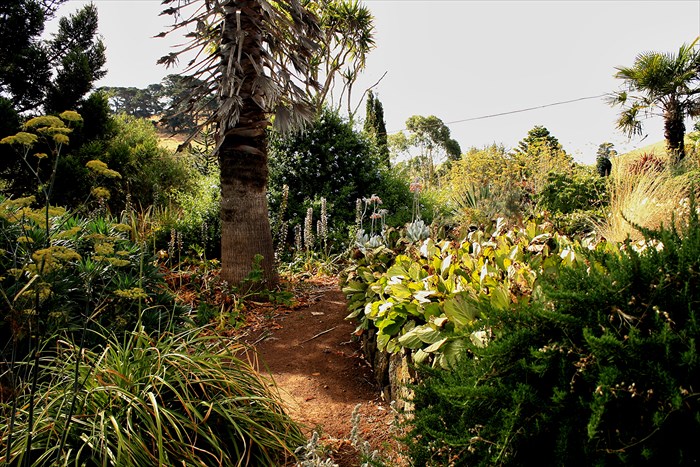 ... a mess in the best sense of the word, in the original sense of mess as food, but food for the spirit and the mind. The challenge is to understand "mess" in a new way, to be able to perceive a difficult beauty, one not easily available to those concerned with tidiness and propriety. This is mess in the sense a Helen Frankenthaler or a Jackson Pollock is a mess.
... a mess in the best sense of the word, in the original sense of mess as food, but food for the spirit and the mind. The challenge is to understand "mess" in a new way, to be able to perceive a difficult beauty, one not easily available to those concerned with tidiness and propriety. This is mess in the sense a Helen Frankenthaler or a Jackson Pollock is a mess. I need to clarify lest my use of mess be misunderstood. I've seen the word "mess" applied pejoratively to many gardens--my own included. At other times I've despaired as garden designers and writers use the word apologetically, trying to convince gardeners and homeowners to adopt a looser, more naturalistic style beneficial to wildlife and a more sustainable ecology, to accept a little bit of messiness for the good of nature. The North American "lawn" culture, and its powerful, so-called landscaping industry, has so deluded the potential gardening public that only neat, carefully manicured, boring (and barren) lawns and tidy gardens are acceptable. In many suburban areas it is illegal to have anything else. Wigandia could not be more different from this. For a start, note the lack of a proper lawn in front of Mr. Martin's Victorian cottage. But that's only the start. Wigandia is different from most other gardens in many ways.
I need to clarify lest my use of mess be misunderstood. I've seen the word "mess" applied pejoratively to many gardens--my own included. At other times I've despaired as garden designers and writers use the word apologetically, trying to convince gardeners and homeowners to adopt a looser, more naturalistic style beneficial to wildlife and a more sustainable ecology, to accept a little bit of messiness for the good of nature. The North American "lawn" culture, and its powerful, so-called landscaping industry, has so deluded the potential gardening public that only neat, carefully manicured, boring (and barren) lawns and tidy gardens are acceptable. In many suburban areas it is illegal to have anything else. Wigandia could not be more different from this. For a start, note the lack of a proper lawn in front of Mr. Martin's Victorian cottage. But that's only the start. Wigandia is different from most other gardens in many ways. Gardens need more mess--not chaos, mess. Like play. Mess can be the birthplace of meaning (think of the child's sandbox). In a garden, the mess of life can find meaning; the process is an artistic one, a personal exploration and discovery.
Gardens need more mess--not chaos, mess. Like play. Mess can be the birthplace of meaning (think of the child's sandbox). In a garden, the mess of life can find meaning; the process is an artistic one, a personal exploration and discovery.
William warned us of the possibility of wildfires along the road as we approached the vicinity of Mount Noorat--a deadly byproduct of the severe summer drought. Anticipating a judgment of "messy" perhaps, he told us Wigandia, which we visited on February 6, just past the height of the Australian summer, was probably as stressed as it had ever been (nothing is watered artificially), and he would normally not have visitors at such a time. This is not because he fails to see the beauty of his garden in a dry summer, but because he thinks many visitors might not be able to appreciate it. And, of course, most garden visiting is done in the spring and fall, not high summer, many hours distant from the nearest major city. But … since we had traveled a very long way, and I had been corresponding with him for several years … he invited us to see his beauties of death and distress.On the side of an extinct volcano, William Martin’s garden is dramatically sited, with clear views into the surrounding landscape of arid hills and gentle troughs. It’s a difficult site that allows no plants not drought resistance, and a dry, volcanic soil red as Mars. The garden is screened and protected to some extent by an irregular scrim of trees, principally the thin-leaved Casuarina (Sheoak); the frequent views out into the hilly landscape dotted with grazing cows plays tricks with your sense of scale. In a quick glance, I could turn my attention from tiny trees and dots of cows a quarter mile distant, to the small radiant beauty of a sun-drenched Aeoniam imitating a rose in the rocks at my side. The psychological effect was exhilarating.
But … since we had traveled a very long way, and I had been corresponding with him for several years … he invited us to see his beauties of death and distress.On the side of an extinct volcano, William Martin’s garden is dramatically sited, with clear views into the surrounding landscape of arid hills and gentle troughs. It’s a difficult site that allows no plants not drought resistance, and a dry, volcanic soil red as Mars. The garden is screened and protected to some extent by an irregular scrim of trees, principally the thin-leaved Casuarina (Sheoak); the frequent views out into the hilly landscape dotted with grazing cows plays tricks with your sense of scale. In a quick glance, I could turn my attention from tiny trees and dots of cows a quarter mile distant, to the small radiant beauty of a sun-drenched Aeoniam imitating a rose in the rocks at my side. The psychological effect was exhilarating. As the glimpses of the landscape from the hillside garden play with perceptions of space and scale ...
As the glimpses of the landscape from the hillside garden play with perceptions of space and scale ... ... so the plantings at the more intimate scale within the garden play with one's expectations, as the "mess" of vegetation reveals sun-colored succulents like gems hiding in the rough, or as varied views and perspectives appear as you walk about the garden. There are many surprises, even jokes.
... so the plantings at the more intimate scale within the garden play with one's expectations, as the "mess" of vegetation reveals sun-colored succulents like gems hiding in the rough, or as varied views and perspectives appear as you walk about the garden. There are many surprises, even jokes.




 One joke ... when I stumbled over this wire basket of rusty cans and rebar--William told me to take care, I might damage the memorial to his 4oth birthday (his shoe is visible too).
One joke ... when I stumbled over this wire basket of rusty cans and rebar--William told me to take care, I might damage the memorial to his 4oth birthday (his shoe is visible too).
What may appear to be random is highly contrived. These barrel cacti planted in repurposed roof ventilators show just how self-consciously designed Wigandia is. William Martin introduces many disparate elements into the garden--an old red automobile, rusted metal chairs, an old rusty mine from World War II, a great deal of reworked rebar rusted to the color of the soil--all to intentional effect, sometimes aesthetic, sometimes as a poke in the eye of the traditional garden establishment. Wigandia is very much made in reaction to traditional Australian gardens which, since the nation's inception, slavishly imitated British gardens, totally ignoring the vastly different climate and indigenous plants. Mr. Martin was among the first to rebel against this long-established, increasingly moribund tradition, and he remains very much the rebel.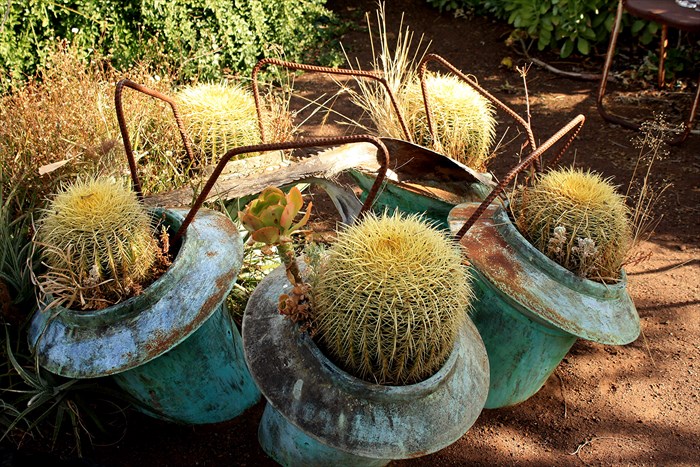 He continues to challenge traditional views of what a garden is, and what belongs in a garden, as you can see ...
He continues to challenge traditional views of what a garden is, and what belongs in a garden, as you can see ...

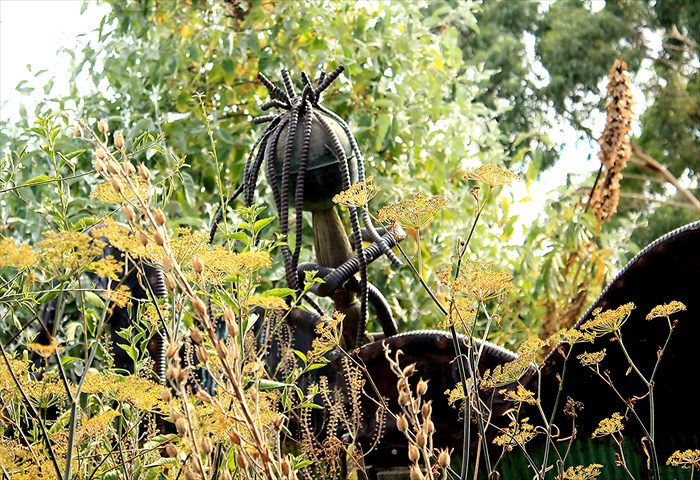
 Here is William Martin, if not at rest, at least still for a moment. I'm tempted to say, at play in his fields of glory. He can talk a blue streak, and he's quite an engaging garden tour guide. One of my major regrets is having only two hours in the garden, and because of our long route back, leaving just as the sun was about to set, and having to miss seeing the garden in slanting, low light and long shadows.
Here is William Martin, if not at rest, at least still for a moment. I'm tempted to say, at play in his fields of glory. He can talk a blue streak, and he's quite an engaging garden tour guide. One of my major regrets is having only two hours in the garden, and because of our long route back, leaving just as the sun was about to set, and having to miss seeing the garden in slanting, low light and long shadows.
 The garden is structured more or less as irregular, concentric circles, at different levels, with the house at the uppermost point, serving as a center and focal point. The circular paths are perceived as random rambles around the garden, not as geometric structure, and the way is blocked in places, perhaps by a fallen plant. Occasionally a space opens up, creating voids that give the fullness of the garden breathing room.
The garden is structured more or less as irregular, concentric circles, at different levels, with the house at the uppermost point, serving as a center and focal point. The circular paths are perceived as random rambles around the garden, not as geometric structure, and the way is blocked in places, perhaps by a fallen plant. Occasionally a space opens up, creating voids that give the fullness of the garden breathing room. This is a garden of sculptural presence, but color is immensely important too--even in a time of intense heat the silvery tans and browns of dying and dead plants, as well as many bright yellows and yellow greens reflect the light--and ever present, the red soil.Here is a fallen Furcraea, a Mexican plant, I would guess fifteen feet long and weighing several hundred pounds, which lies alongside the path. As well as its bright color, itself unusual for a dead plant, the fallen trunk has a sculptural presence almost like a living thing, like an idol, certainly a symbol. It is part of the contrast of large and small, hard and soft, near and far that adds to the experiential richness of this garden. The falling was a chance occurrence; the decision to leave it where it fell was intentional. (Another fallen Furcraea can be seen at the back of the red dirt clearing in the photo above.)
This is a garden of sculptural presence, but color is immensely important too--even in a time of intense heat the silvery tans and browns of dying and dead plants, as well as many bright yellows and yellow greens reflect the light--and ever present, the red soil.Here is a fallen Furcraea, a Mexican plant, I would guess fifteen feet long and weighing several hundred pounds, which lies alongside the path. As well as its bright color, itself unusual for a dead plant, the fallen trunk has a sculptural presence almost like a living thing, like an idol, certainly a symbol. It is part of the contrast of large and small, hard and soft, near and far that adds to the experiential richness of this garden. The falling was a chance occurrence; the decision to leave it where it fell was intentional. (Another fallen Furcraea can be seen at the back of the red dirt clearing in the photo above.) At this time of year, the color yellow pervades the garden. It's in much of the stressed foliage. And it's present in thousands of plants of blossoming bronze fennel, one of the main matrix plants of Wigandia.
At this time of year, the color yellow pervades the garden. It's in much of the stressed foliage. And it's present in thousands of plants of blossoming bronze fennel, one of the main matrix plants of Wigandia.
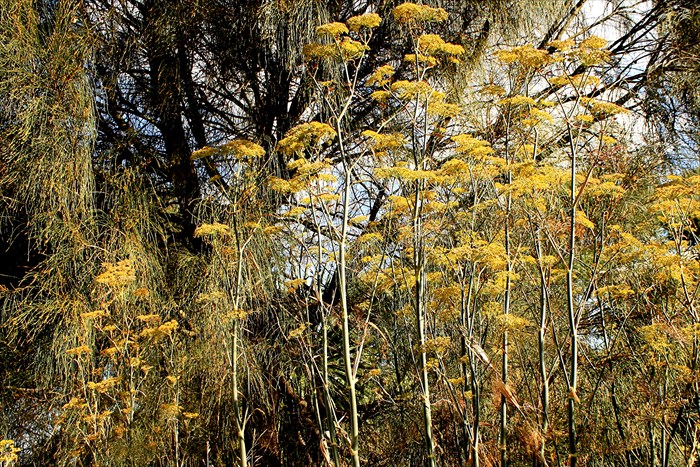
 The airy lightness of the pavilion William built of farm implements high up in the garden (below) invites fantasy of some airy world ...
The airy lightness of the pavilion William built of farm implements high up in the garden (below) invites fantasy of some airy world ... ... and provides a good place for viewing the surrounding landscape, in addition to satirizing more traditional garden pavilions.
... and provides a good place for viewing the surrounding landscape, in addition to satirizing more traditional garden pavilions.
I hope I haven't tried too hard to analyze this garden because my experience of it was intensely emotional, not intellectual. So I'll close with an appropriate quote from William Martin's recent blog post:
"I only ever wanted to create a garden of beauty..."
To see larger photos of Wigandia, which I recommend, see my Wigandia photo set on flickr.








